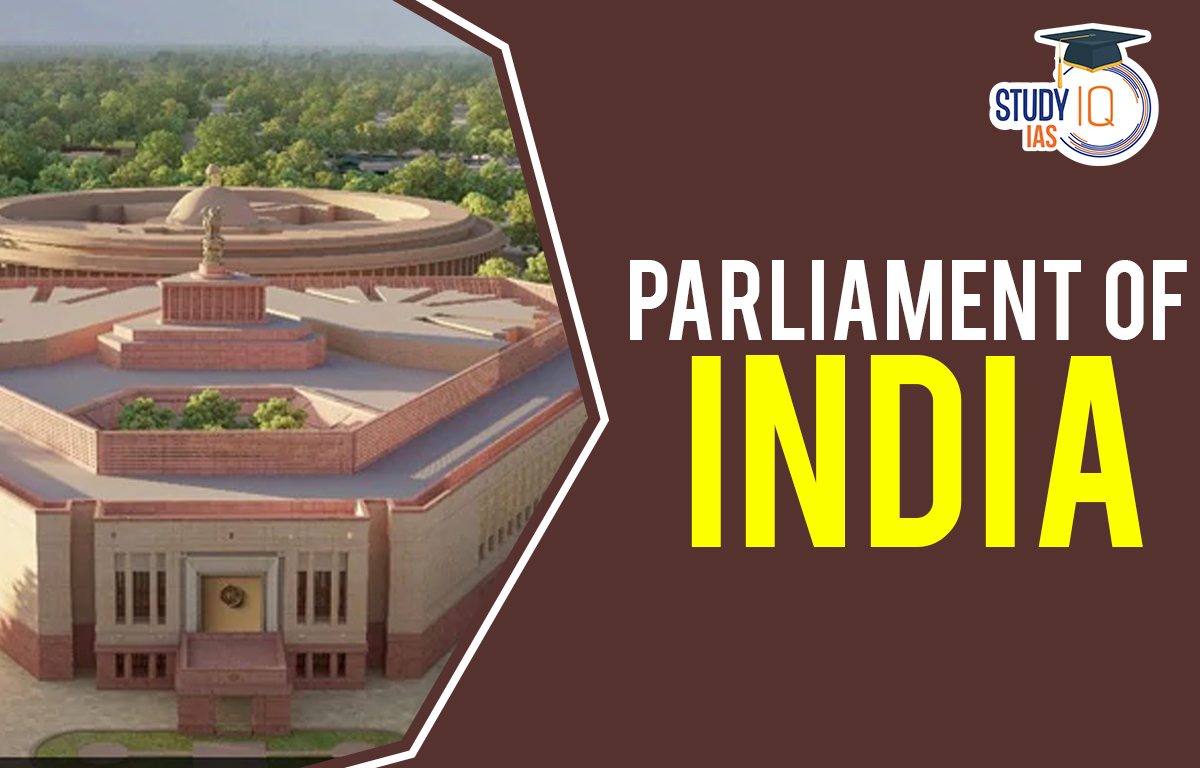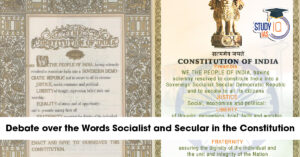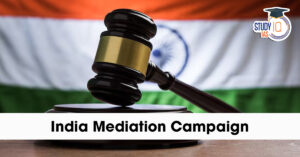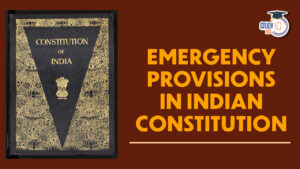Table of Contents
Parliament of India
India’s Parliament is its top legislative body. The two Houses that make up the Indian Parliament are the Lok Sabha (House of the People) and the Rajya Sabha (Council of States). The President has the authority to prorogue any House of Parliament, call a session of that House, and dissolve the Lok Sabha. The Indian Constitution went into effect on January 26 of that year.
The Parliament is an important part of Indian Polity which an important subject in UPSC Syllabus. Students can also go for UPSC Mock Test to get more accuracy in their preparations.
Parliament of India Background
The Parliament of India is the legislative branch of the Indian government; the executive and judicial branches are the other two. In India’s democratic system, the “Parliamentary form of government” grants the Indian parliament a significant role. A true democracy must have a representative, effective, and efficient legislature.
The legislature also helps citizens keep politicians responsible. In fact, this is the fundamental tenet of representative democracy. The legislature’s tasks include more than just passing laws. It is the centre of all democratic political processes. The legislature is the most representative body in the government. The legislature is more representative and may even be more responsive to popular expectations simply because there are members from a variety of social backgrounds.
Houses of Parliament of India
The Houses of Parliament of India, also known as the Sansad Bhavan, is the building that houses the two chambers of the Indian Parliament – the Lok Sabha (House of the People) and the Rajya Sabha (Council of States). The building is located in New Delhi, the capital of India, and is one of the most iconic landmarks of the city.
Rajya Sabha
About
The Upper House sometimes referred to as the Second Chamber or House of Elders, is comprised of representatives from the Indian Union’s states and union territories. The Rajya Sabha is referred to as the permanent House of Parliament because it never disbands entirely. The Indian Constitution’s IV Schedule addresses the allocation of Rajya Sabha seats to the states and UTs.
Rajya Sabha Composition
Rajya Sabha is limited to 250 members, of whom 12 are president-nominated and 238 are representatives of states and UTs (elected indirectly). There are presently 245 members of the House, of whom 229 are from the states, 4 are from UTs, and 12 were nominated by the president.
Rajya Sabha Election of Representatives
The representatives for each state are chosen by the members of the state legislative assembly. The MPs from each UT in the Rajya Sabha are indirectly chosen by members of an electoral college constituted specifically for the purpose. Only three UTs (Delhi, Puducherry, and Jammu & Kashmir) are represented in the Rajya Sabha (others do not have adequate populations).
Rajya Sabha Power & Function
The president’s list of candidates includes members with distinctive expertise or practical experience in the humanities, sciences, literature, or social services. Without holding elections, it is intended to provide famous individuals a seat in the parliament. The Rajya Sabha is crucial for reviewing and changing laws that the Lok Sabha proposes.
In order for a piece of legislation to become law, it must pass the Rajya Sabha. It can also propose laws. In the Rajya Sabha, the States are represented. As a result, it needs to be considered before making any choices that would affect the States. Any item that the Union Parliament requests be removed or transferred from the State list must receive the Rajya Sabha’s approval.
Also Read: Union Legislature
Lok Sabha
About
The Lower House sometimes referred to as the First Chamber or Popular House is where all Indians are represented.
Lok Sabha composition
A maximum of 550 people may serve in the Lok Sabha, of which 530 must be state lawmakers and 20 must come from UTs. Currently, there are 543 members of the Lok Sabha, 530 of them are from the states and 13 from the UTs. The President had also recommended two representatives from the Anglo-Indian community before the 95th Amendment Act of 2009, however, this provision was only valid until 2020.
Lok Sabha Election of Representatives
The state representatives are chosen directly by the residents of the states’ territorial districts. The Union Territories (Direct Election to the House of People) Act of 1965 provides for the direct election of UT residents to the Lok Sabha.
Lok Sabha Power and Function
One of the most important responsibilities of the Lok Sabha is choosing the executive, a group of individuals who work together to implement the laws established by the Parliament. The term “government” is frequently used to refer to this executive.
Both Houses are required to approve every ordinary law. But in the event of a dispute between the two Houses, a joint session of both Houses is called to reach a decision. Due to its superior strength, the Lok Sabha’s position has a higher chance of success in such a conference. The Lok Sabha has greater power over finances. Once the government’s budget or any other financial action has been passed by the Lok Sabha, the Rajya Sabha cannot reject it. The Rajya Sabha can only amend it or postpone it for 14 days; the Rajya Sabha may or may not adopt these ideas.
The Lok Sabha has authority over the Council of Ministers. If the majority of Lok Sabha members vote “no confidence” in the Council of Ministers, the Prime Minister and every other minister are required to resign. This power is absent from the Rajya Sabha.
President
About
Despite not being a member of either House and not participating in sessions, the President of India is a crucial component of the Parliament. The head of state is the person with the highest position of authority in the country. The elected Members of Parliament (MPs) and Members of the Legislative Assemblies (MLAs) elect the President of India.
President Power
A bill adopted by both Houses of Parliament cannot become law without the President’s consent. He has the power to convoke and prorogue both Houses when they are not in session, dissolve the Lok Sabha, and make ordinances.
Parliament of India Functions
The Parliament of India performs several important functions, including:
- Legislative Functions
- Executive Functions
- Financial Function
- Electoral Functions
- Judicial Functions
- Amending Powers
Legislative Functions
All topics listed in the Union List and the Concurrent List are subject to legislative action by the Parliament. The union legislation shall take precedence over the states on the Concurrent List, where the state legislatures and the Parliament share jurisdiction unless the state law had previously acquired presidential assent. However, the Parliament has the authority to add to, modify, adjust, or revoke a state legislature-enacted law at any moment.
The Parliament may also pass laws on items on the State List if an Emergency is in effect or if any state is subject to President’s Rule (Article 356). According to Article 248, the Rajya Sabha must pass a resolution by a 2/3 majority of its members present and voting stating that it is necessary for the Parliament to pass laws on any matter listed in the State List in order to protect the interests of the country.
In accordance with Article 253, it may make laws pertaining to State List items if they are necessary for the execution of treaties or international agreements with foreign countries. According to Article 252, the Parliament may enact laws for those states if the legislatures of two or more states pass a resolution stating that it is desirable to have a parliamentary law on any matter specified in the State List.
Executive Functions
The executive under a parliamentary system of government answers to the legislature. As a result, the Parliament uses a variety of tools to exert influence over the government. The Parliament has the authority to overthrow the Cabinet (Executive) by a vote of no confidence. It has the right to reject any law introduced by the Cabinet, including budget proposals. A motion of no-confidence is adopted to overthrow a government.
The ministers can be questioned by the MPs (Members of Parliament) on their commissions and omissions. Any mistakes made by the government may be brought to light in Parliament. The main goal of an adjournment motion, which is only permitted in the Lok Sabha, is to bring the Parliament’s attention to any current matter of urgent public interest. Given that it has an impact on routine business; it is seen as an extraordinary tool in Parliament. The Ministerial Assurances Committee, which the Parliament appoints, monitors whether the ministers’ promises to the Parliament are kept.
Members of the opposition parties in the House introduce a motion of censure to express their vehement disagreement with any government policy. Only in the Lok Sabha can it be moved. The government is required to ask the House for its confidence as away once a motion of censure is approved. The Council of Ministers need not quit if the censure motion is approved, unlike in the case of the no-confidence motion. A cut motion is used to oppose any demand made by the government in the financial bill.
Financial Functions
When it comes to money, Parliament is the final arbiter. Without parliamentary authorization, the Executive is not allowed to spend a single pie. The Cabinet presents the Union Budget to the Parliament for approval. The Parliament must also accept any tax enactment ideas. The Parliament’s Public Accounts Committee and Estimates Committee are two permanent committees that monitor how the executive uses funds provided by the legislature.
Electoral Functions
The election of the President and Vice President includes participation from the Parliament. The elected members of both Houses make up part of the Electoral College, which chooses the President. A Rajya Sabha resolution that is approved by the Lok Sabha can remove the President.
Judicial Functions
The Parliament has the authority to punish members of the House who violate a privilege. When one of the rights afforded by MPs is violated, it is a breach of privilege. When a member believes that a minister or another member has violated the privilege of the House or one or more of its members by withholding relevant facts from a case or by providing false or distorted information, the member may file a privilege motion.
Legislative privileges in a parliamentary system are unaffected by judicial oversight. In general, judicial review does not apply to the Parliament’s ability to punish its members. The Parliament also has the authority to remove judges from the Supreme Court, High Courts, Auditor-General, and other judiciary positions.
Amending Powers
The Indian Constitution may be amended by the Parliament. The power to modify the Constitution is equally split between the two Houses of Parliament. For amendments to take effect, they must be approved by both the Lok Sabha and the Rajya Sabha.
Parliament of India Significance
Important issues both domestically and internationally are discussed in the parliament. In this sense, the opposition is crucial in ensuring that the nation is aware of opposing viewpoints. People from a variety of ethnic, racial, linguistic, and ideological backgrounds can take part in the creation of laws and policies because of the parliamentary system of government.
In a democracy, the Parliament is in charge of debating significant matters before legislation or resolutions are passed, and it is usually referred to as a “mini-nation”. The state and UT limits may be altered, shrunk, or increased at the discretion of the Parliament. The House of the People is a resource for information as well.
Parliament of India UPSC
Achieving the constitutional objectives depends on Parliament, a crucial political and constitutional institution that provides the basis for ideals like democracy and people’s representation. Students can read all the details related to UPSC by visiting the official website of StudyIQ UPSC Online Coaching.


 Indian Secularism: Constitutional Provis...
Indian Secularism: Constitutional Provis...
 India Mediation Campaign, Objectives, Pr...
India Mediation Campaign, Objectives, Pr...
 Emergency Provisions in Indian Constitut...
Emergency Provisions in Indian Constitut...





















